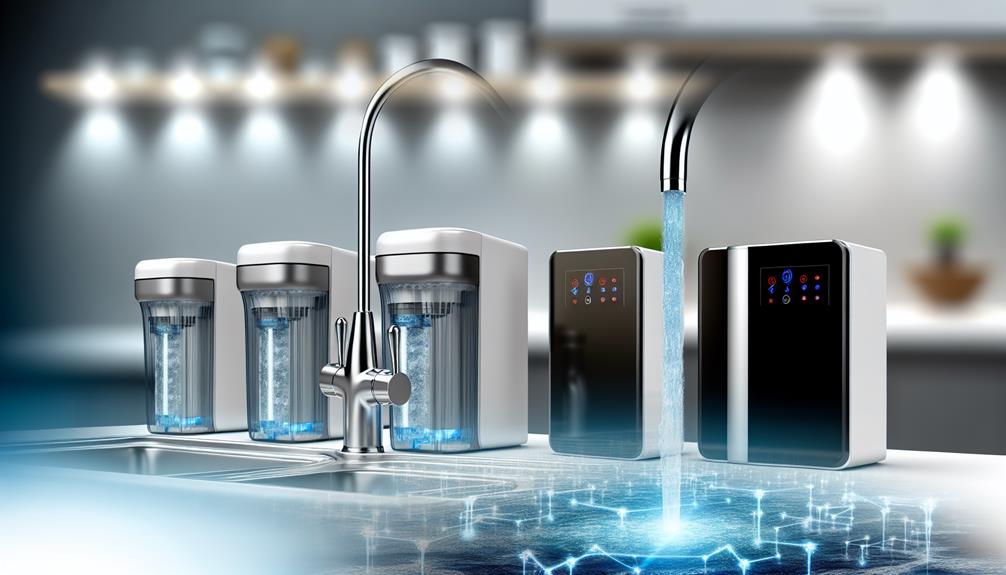As climate change marches on like an unrelenting tide, its impacts on water quality and availability are becoming impossible for you to ignore. You've likely noticed more frequent news about floods, droughts, and contamination—all of which directly affect the water that flows from your tap.
Consequently, you're now faced with a water filter market that's evolving rapidly to meet the demands of a changing climate. You're not just looking for a simple pitcher filter; you're now considering the necessity of advanced filtration systems that can handle a broader spectrum of contaminants.
But just how deeply will these environmental shifts permeate the market? You're standing at the edge of a complex interplay between technology, regulation, and consumer need, and it's crucial for you to understand where this current will sweep the market next.
Rising Sea Levels Influence
Rising sea levels, increasingly affecting coastal and low-lying areas, necessitate a reevaluation of water filter market strategies due to the heightened risk of saltwater contamination in freshwater sources. As climate change accelerates, the thermal expansion of oceans and the melting of polar ice caps and glaciers are causing sea levels to rise, leading to a direct impact on water quality. You're now faced with the challenge of addressing the infiltration of saltwater, which compromises the integrity of water resources.
The surge in sea levels isn't just an environmental impact; it also has critical implications for water purification and treatment systems. Wetlands, river deltas, and coastal regions are particularly vulnerable, as saltwater intrusion can render water undrinkable and unsuitable for agriculture and industry. Consequently, Filtration Systems must innovate to counteract these changes.
Moreover, the increased frequency of storm surges and erosion threatens coastal infrastructure, demanding robust water treatment solutions. As a stakeholder in water filtration, you must adapt to these shifts by integrating advanced technology capable of desalinating and purifying water affected by saltwater contamination. Mitigating carbon emissions is also essential in your long-term strategy, as it addresses the root cause of sea level rise. Therefore, your approach should incorporate both immediate and sustainable water resource management practices.
Extreme Weather Patterns Impact
While sea level rise demands urgent attention in water filtration strategies, extreme weather patterns also pose significant challenges, necessitating resilient and adaptable purification systems to ensure safe drinking water. Climate changes are prompting a critical examination of current water management policies, with a clear focus on the energy required to maintain water safety in turbulent times.
Here's an analytical breakdown of how extreme weather patterns impact the water filter market:
- Increased Contamination Risks: Flooding and natural disasters elevate the risk of waterborne diseases by introducing pollutants, thus heightening the importance of filtration technologies capable of removing contaminants efficiently.
- Infrastructure Strain: The unpredictability of climate-induced weather events puts a strain on existing water infrastructure, disrupting supply and amplifying the need for reliable home water filtration systems.
- Innovation Drive: A surge in demand for portable and durable water filters is evident as consumers seek solutions that water requires to be both accessible and pure despite environmental uncertainties.
- Quality and Availability Shifts: Extreme weather patterns lead to changes in water quality and availability, underscoring the necessity for versatile water filtration systems that can adapt to varying conditions.
Adopting a data-driven, policy-oriented approach will be key in developing water management strategies that can withstand the tumultuous effects of climate on water resources.
Water Scarcity and Filtration Demand
As water scarcity intensifies, the demand for home water filtration systems escalates, providing a critical solution for access to purified water. You're witnessing a shift towards sustainable water filters, driven by the need for safe and clean water amidst dwindling resources. Advanced filtration technologies, such as reverse osmosis, are becoming more prevalent, addressing water conservation concerns while ensuring access to safe drinking water.
In developing countries, the urgency is more pronounced. Limited infrastructure amplifies the threat of waterborne diseases, propelling filtration demand. Innovations like DetoXyFi's biodegradable filter, utilizing waste wood, offer affordable and eco-friendly alternatives to traditional systems. Such solutions not only improve health outcomes but also mitigate the impact on the environment.
The rise of nonwoven materials in filtration underscores the industry's response to water scarcity. These materials are crucial in purifying drinking water, highlighting the intersection of water quality and conservation. Moreover, energy-efficient filtration systems are no longer a luxury but a necessity, reducing energy consumption and fostering long-term cost savings.
Your understanding of these dynamics is crucial. Policy-oriented approaches must champion the deployment of sustainable and efficient water filtration systems to combat the adverse effects of water scarcity on a global scale.
Regulatory Changes Shaping Markets
Regulatory shifts are dictating new standards for home water filtration systems, potentially transforming manufacturing practices and consumer access to these essential products. As you navigate this evolving landscape, it's crucial to understand how these regulatory changes could redraw the contours of the water filter market.
Consider the following impacts:
- Market Research Adjustments: Regulatory shifts necessitate updated market research to anticipate consumer needs and compliance costs.
- Sustainability Initiatives: A focus on reducing carbon footprints leads to the development of eco-friendly filtration technologies that minimize plastic waste and improve wastewater treatment.
- Supply Chain Revisions: Regulations may force supply chain modifications to ensure water and water safety products meet new environmental standards.
- Projected Market Growth: The market is projected to grow as regulations push for advanced filtration solutions that prioritize health and sustainability.
These policy-oriented adjustments require manufacturers to innovate, lest they fall behind in a competitive field where the rules of the game are changing. Your strategy must account for the dual pressures of adhering to stricter regulations and the consequent market dynamics. Staying informed and agile will be key to thriving in a market where regulatory compliance is as important as product quality.
Innovation in Water Filtration Tech
Understanding the implications of regulatory changes on the water filter market positions you to appreciate the surge in innovative water filtration technologies that are enhancing water purity and energy efficiency.
Innovation in water filtration tech isn't only advancing the removal of traditional contaminants but also addressing emerging pollutants. Modern systems are adept at eliminating biological contaminants, heavy metals, and harmful chemicals through advanced mechanisms such as carbon filtration and membrane filtration.
Companies like DetoXyFi are revolutionizing the manufacturing process by utilizing waste wood as a raw material, creating sustainable filters that purify water with minimal energy consumption. This innovation underscores the need for solutions that align with both environmental and economic goals, particularly in providing rapid deployment for disaster relief.
The role of nonwovens in filter uses is expanding, driving growth in the market and facilitating the production of filters that meet stringent regulatory standards. With a focus on energy-efficient and high-performance filtration systems, industry players are pushing the boundaries of what's possible, particularly in regions like North America and Asia-Pacific where demand for cleaner water is accelerating.
This proactive approach in developing cutting-edge water filtration technologies is crucial for adapting to the challenges posed by climate change.

